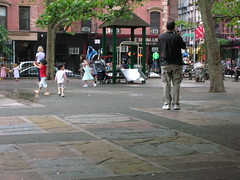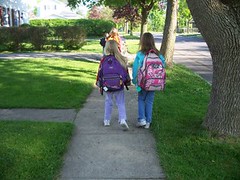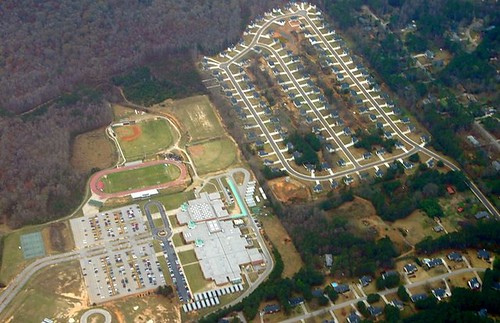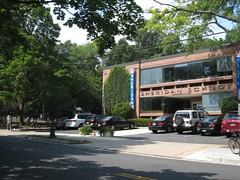Great principles for “smart growth schools”

Posted June 29, 2009 at 1:33PM
Last fall, I posted a two-part photo essay on school sprawl and the alternatives. As I wrote then (in Part 1), "schools used to be the heart of a neighborhood or community. Children and not a few teachers could walk to class, or to the playground or ball field on the weekend. This was relatively easy to do, because the schools were placed within, not separated from, their neighborhoods. They were human-scaled and their architecture was not just utiliatarian, but signaled their importance in the community. Now it has become hard to tell one from a Walmart or Target."
In Part 2, I presented some examples of schools that fit well into their communities, including two in my DC neighborhood, pictured below.
Now, thanks to a post by Penelope Grzebik in the CNU Salons, I have learned there is a website dedicated to providing resources on "smart growth schools." The site, which includes a well-annotated "report card," a listserv, links to some very good resources, and a pathway to hands-on assistance, was created by Nathan Norris, who has been developing community performance indicators for at least a decade.
The report card is especially good, 24 pages of great tips and advice based around eleven key principles:
1. Restoration Preference
Will old schools be restored rather than replaced so long as the cost is less than a new school? This is a separate question than whether the school building will be recycled for another use (i.e., adaptive reuse).
2. Holistic Planning
Is school planning done in conjunction with land planning and transportation planning or are these segregated?
3. Community buy-in
Is the school planning process designed in a way to secure meaningful community input prior to key decisions being made?
4. Elimination of design constraints
Do you have the flexibility to design the school efficiently for the site and the community?
5. Neighborhood School
Is the school embedded into a walkable neighborhood so that most students can reach it safely without the necessity of a car or bus?
6. Prominent Site
Is the school sited in a prominent location (e.g., terminated vista or on top of a hill) so that it communicates the importance the school has in the culture of the community?
7. Shared Use
 Is the school sited or designed so that it can share uses with the community such as a gym (or YMCA), park, ballfields, community meeting space, daycare, library, performance theater, art studio, cafeteria/restaurant, community garden, health clinic, etc.?
Is the school sited or designed so that it can share uses with the community such as a gym (or YMCA), park, ballfields, community meeting space, daycare, library, performance theater, art studio, cafeteria/restaurant, community garden, health clinic, etc.?
8. Flexibility
Is the school designed so that it can grow (independent additional wings, floors or structures) or contract in size and services (areas can be removed or adaptively reused if no longer used for school purposes) as the neighborhood grows or contracts so that it remains useful over a longer period of time?
9. Connected Learning Environment
Does the school connect itself to effective distance learning opportunities; is the school connected to the local community through interaction with local businesses or through a community service program?
10. Community Pride in the Design
Is the school designed so that it generates community pride as measured by a Visual Preference Survey (VPS)?
11. Green building certification
Does the construction or renovation of the school follow best practices regarding energy efficiency, water efficiency, indoor air quality, daylighting, light pollution and earth-friendly construction techniques as set out in the LEED for Schools program?
 Norris explains the thinking behind smartgrowthschools.org:
Norris explains the thinking behind smartgrowthschools.org:
"The Smart Growth Schools website is designed to make it easier for people to understand how they can improve their communities and schools by considering issues that are oftentimes ignored in the school planning process. These issues pertain to the intersection between Smart Growth and K-12 schools. Paying attention to these issues will result in communities saving money, decreasing the environmental impact of schools on the community, improving the health of students, and increasing the long-term support for the school system by those who do not have school-aged children."
What a great way to think about such a vital neighborhood resource.


